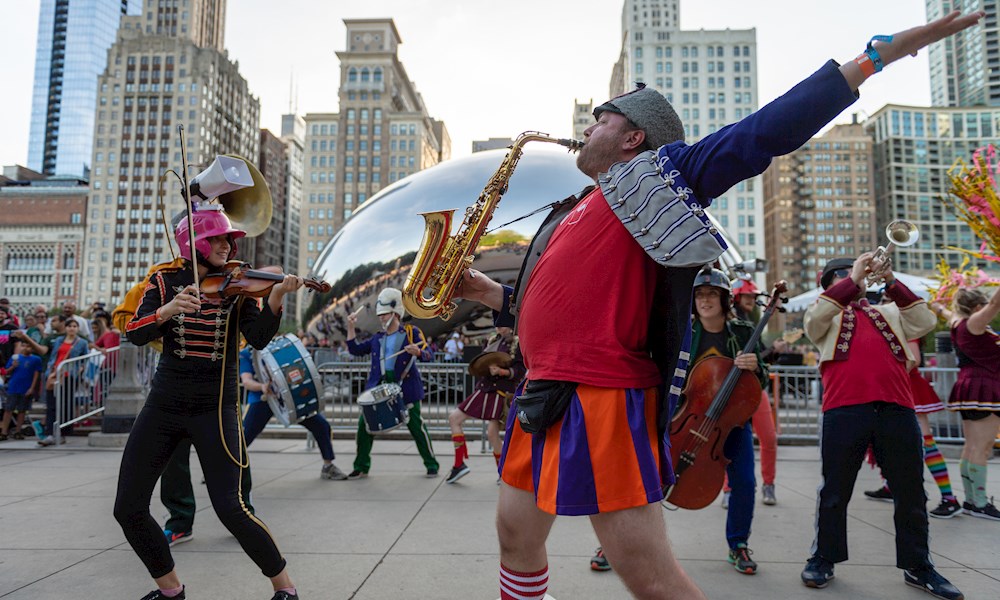- Sector Scan
Chicago Continues its Legacy as a Robust Arts Community
- Posted Apr 13, 2023
5-minute read
As the third-largest metropolitan region in the nation, Chicago-Naperville-Evanston, IL continues its legacy as one of the top 10 communities on the 2022 Arts Vibrancy Index Report. With high scores across all three measures of art providers, arts dollars, and government support for the arts, Chicago shows particular strength in the number of independent artists, compensation levels for arts and cultural employees, and state funding per capita.

Over the years, Chicago has established itself as an incubator for artistic voices, where new work, new voices, and experimentation are valued. “There is so much new work being created each year. We are also an extremely diverse city, which adds to the many textures of the work. Audiences have a wide-ranging and sophisticated palate,” states Ellen Placey Wadey of the Gaylord and Dorothy Donnelley Foundation.
The city serves as a mecca for artists across the Midwest (and other regions) offering a relatively affordable big city with a welcoming Midwestern attitude. The city offers many of the same amenities as New York and California, but at a fraction of the cost with a 45% lower cost of living average than Brooklyn and 26% lower than Los Angeles.
In terms of its general population, Chicago is on par with both New York and Los Angeles for its diverse racial and ethnic makeup, which local arts leaders recognize as a strength in its ability to foster a robust arts community. In fact, the city’s reputation as an artistic hub and cultural destination spans numerous disciplines.
Chicago is credited as the birthplace of storefront and improv theater, slam poetry, and more than 250 theater companies. Additionally, one of the city’s best-known artistic contributions is its formative role in blues, soul, jazz, and gospel music along with more contemporary forms such as house, hip-hop, and dance. For visual arts, the School of the Art Institute of Chicago remains one of the most historically significant, accredited, independent schools for art and design in the nation.
Over the past 5-7 years, arts activity has grown and expanded on the south and west sides of the city. New venues provide anchor spaces, allowing arts organizations to bring new and diverse work to a wider range of individuals. With the presence of ardent service agencies such as Arts Alliance Illinois, Chicago Artist Coalition, the Arts and Business Council, or discipline-specific organizations such as See Chicago Dance, Chicago Dancemakers Forum, and the League of Chicago Theatres, Chicago’s artistic community is backed by an army of support.
With the continuation of the pandemic and its lingering effects on the sector, attention to artists as members of the labor force and arts equity took precedence in recovery strategies. In 2021, the City of Chicago announced Arts 77 as a citywide arts recovery and reopening plan to support local artists and organizations across Chicago’s 77 neighborhoods, as well as a dedicated $2.3 million Chicago Creative Worker Relief Fund.
In 2022, the City of Chicago made an unprecedented commitment to the arts, announcing $26 million in new investments, making Chicago one of the top major U.S. cities in government support for arts recovery and artist relief.
This increase in direct support has led to major strides for the 2022 CityArts Program, which provides general operating support and project grants to local arts organizations of all sizes and across all artistic disciplines. In 2022, there was more than a 250% increase in the funds available through the program, climbing from $1.7 million in 2021 to roughly $6 million in 2022.
Additionally, the Department of Cultural Affairs and Special Events (DCASE) deployed $16 million in federal American Rescue Plan Act funding to support new grant and relief programs, tourism and industry support, and citywide marketing efforts. The State of Illinois also announced $50 million for relief and recovery of the creative sector through the Illinois Department of Commerce and Economic Opportunity in 2023.
Chicago’s historical and current commitment to investment in the arts is reflected in its scoring in the top 5% of communities on overall Arts Dollars and Government support per capita, according to the latest Arts Vibrancy Index Report.
On February 16, 2023, the Chicago Plan Commission formally adopted We Will Chicago, a 10-year, citywide planning initiative that places arts and culture as one of the eight core pillar areas alongside housing, climate, and public safety. The plan states, “Arts and culture are essential components of community life, fostering a sense of belonging and shared identity, educational and economic benefits, and improvements to the social and physical wellbeing of residents.”
Thank you to Melanie Wang of the City of Chicago Department of Cultural Affairs and Special Events and Ellen Placey Wadey of Gaylord and Dorothy Donnelley Foundation for their thoughtful contributions to the making of this article.
ABOUT THE ARTS VIBRANCY INDEX
The Arts Vibrancy Index examines the level of supply, demand, and government support of the arts in more than 900 communities across the country. Accompanied by an interactive Arts Vibrancy Map that reveals the arts-vibrancy score of every county in the U.S., the Index lists, in alphabetical order, the 20 most arts-vibrant large cities, the 10 most arts-vibrant medium cities, and the 10 most arts-vibrant small cities. In this year’s Index, the first since 2020, four communities debut on the lists, and an additional five return after an absence of at least three years.



Comments
Leave yours below.